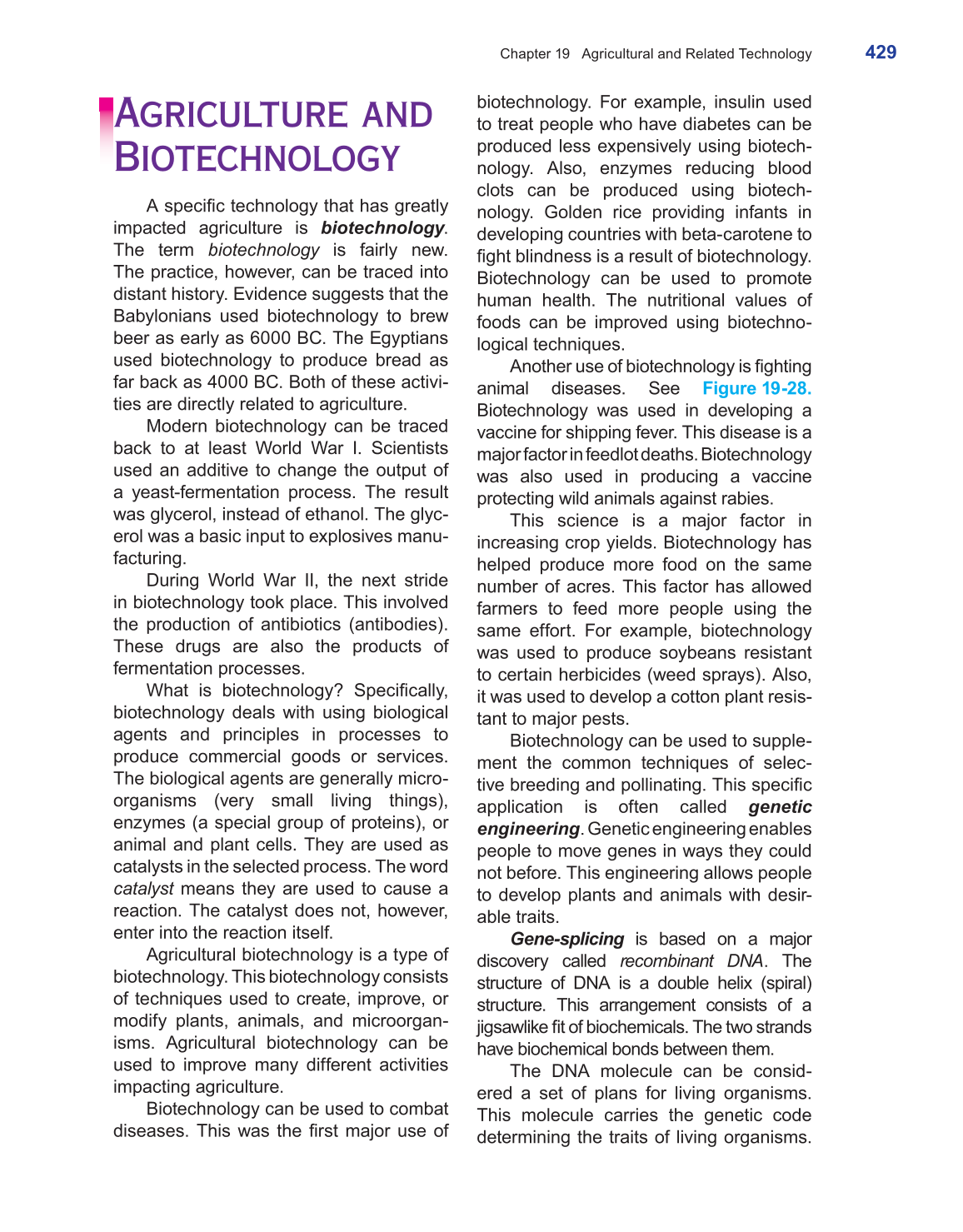Chapter 19 Agricultural and Related Technology
429
Agriculture and
Biotechnology
A specific technology that has greatly
impacted agriculture is biotechnology.
The term biotechnology is fairly new.
The practice, however, can be traced into
distant history. Evidence suggests that the
Babylonians used biotechnology to brew
beer as early as 6000 BC. The Egyptians
used biotechnology to produce bread as
far back as 4000 BC. Both of these activi-
ties are directly related to agriculture.
Modern biotechnology can be traced
back to at least World War I. Scientists
used an additive to change the output of
a yeast-fermentation process. The result
was glycerol, instead of ethanol. The glyc-
erol was a basic input to explosives manu-
facturing.
During World War II, the next stride
in biotechnology took place. This involved
the production of antibiotics (antibodies).
These drugs are also the products of
fermentation processes.
What is biotechnology? Specifically,
biotechnology deals with using biological
agents and principles in processes to
produce commercial goods or services.
The biological agents are generally micro-
organisms (very small living things),
enzymes (a special group of proteins), or
animal and plant cells. They are used as
catalysts in the selected process. The word
catalyst means they are used to cause a
reaction. The catalyst does not, however,
enter into the reaction itself.
Agricultural biotechnology is a type of
biotechnology. This biotechnology consists
of techniques used to create, improve, or
modify plants, animals, and microorgan-
isms. Agricultural biotechnology can be
used to improve many different activities
impacting agriculture.
Biotechnology can be used to combat
diseases. This was the first major use of
biotechnology. For example, insulin used
to treat people who have diabetes can be
produced less expensively using biotech-
nology. Also, enzymes reducing blood
clots can be produced using biotech-
nology. Golden rice providing infants in
developing countries with beta-carotene to
fight blindness is a result of biotechnology.
Biotechnology can be used to promote
human health. The nutritional values of
foods can be improved using biotechno-
logical techniques.
Another use of biotechnology is fighting
animal diseases. See Figure 19-28.
Biotechnology was used in developing a
vaccine for shipping fever. This disease is a
major factor in feedlot deaths. Biotechnology
was also used in producing a vaccine
protecting wild animals against rabies.
This science is a major factor in
increasing crop yields. Biotechnology has
helped produce more food on the same
number of acres. This factor has allowed
farmers to feed more people using the
same effort. For example, biotechnology
was used to produce soybeans resistant
to certain herbicides (weed sprays). Also,
it was used to develop a cotton plant resis-
tant to major pests.
Biotechnology can be used to supple-
ment the common techniques of selec-
tive breeding and pollinating. This specific
application is often called genetic
engineering.Geneticengineeringenables
people to move genes in ways they could
not before. This engineering allows people
to develop plants and animals with desir-
able traits.
Gene-splicing is based on a major
discovery called recombinant DNA. The
structure of DNA is a double helix (spiral)
structure. This arrangement consists of a
jigsawlike fit of biochemicals. The two strands
have biochemical bonds between them.
The DNA molecule can be consid-
ered a set of plans for living organisms.
This molecule carries the genetic code
determining the traits of living organisms.
